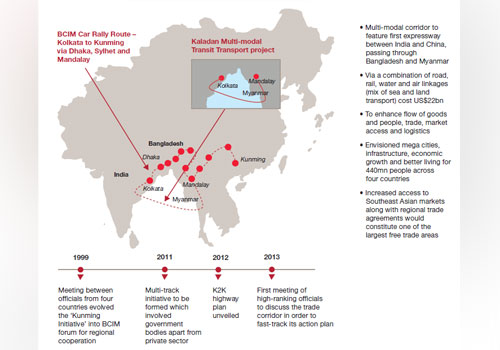Myanmar’s stakes in two Belt and Road economic corridors
The country’s involvement in the two economic corridors reflects its unique geopolitical role in bridging China and South Asia as well as fostering integration of the ASEAN bloc.
MYANMAR is involved in two of the six economic corridors under China’s Belt and Road Initiative (BRI), according to a report from a multinational professional services firm.
The country’s involvement in the two corridors underlines its geopolitical advantage in facilitating the connectivity between China and South Asia as well as in fostering integration within the ASEAN bloc.
The report Repaving the ancient Silk Routes, published by PwC Growth Markets Centre in May, illustrated how Myanmar is involved in two out of six economic corridors in Beijing’s grand scheme: the “amphibious” Bangladesh-China-India-Myanmar corridor, and maritime China-IndoChina Peninsula corridor.
Southeast Asia, along with South and Central Asia, are hotspots for China’s infrastructure investments. All three regions are linked by the six BRI economic corridors.
Four corridors are land routes, including the New Eurasian Land Bridge, the new China-Mongolia-Russia, China-Central Asia-West Asia, and China-Pakistan corridors.
In contrast, the Bangladesh-China-India-Myanmar corridor is a hybrid, or “amphibious” route, and the China-IndoChina Peninsula corridor is an ocean route. Myanmar is involved in these two, which together make up the “21st-Century Maritime Silk Road”.
Each of the economic corridors complements each other and covers energy and transport infrastructure, including railways, highways, power stations, ports and airports. Through these channels, the BRI aims to boost productivity, trade and investment.
BCIM corridor
The Bangladesh- China- India- Myanmar corridor is a multi-modal corridor made up of both land routes mainly via the Kolkata and Kunming (K2K) highway. The sea routes start from Mandalay and end in Kolkata, India. The land routes begin from Kunming, China’s Yunnan regional capital, passing through Myanmar cities such as Mandalay and then Bangladesh through to Kolkata.
PwC estimated that the total cost of a combination of road, rail, water and air linkages for this corridor would reach US$22 billion.
The report said that trade is expected to prosper, and particularly Indian exports such as cotton, copper, electrical machinery and electronic media equipment, chemicals and minerals.
The main artery of the BCIM corridor is a land route – the K2K highway stretches between Kolkata through to Kunming, passing through Bangladesh and Myanmar, spans 2,800km, and is almost ready to operate.
The maritime side of routes, connecting Myanmar to India, is a transport loop which aims to provide maritime access of goods from Kolkata, via Myanmar’s port of Sittwe, to Paletwa by inland water transport along the Myanmar river, Kaladan, and back via highway to Mizoram in northeast India.
This sea route in which Myanmar plays an essential part is in fact highly competitive: compared with the land route, access via sea from Sittwe to Kolkata reduces the distance covered by land by 1,328km to a 539km.
According to information from the Ministry of Development of North Eastern Region of the Indian government, an initial agreement between India and Myanmar was signed back in 2008, but, to date, progress has been slow and the transport loop is yet to become operational.
 Nine cross-national highways form the backbone of Greater Mekong Sub-region (GMS) transport infrastructure. Data from the Hong Kong Trade Development Council. Photo – Supplied/ PwC Growth Markets Centre
Nine cross-national highways form the backbone of Greater Mekong Sub-region (GMS) transport infrastructure. Data from the Hong Kong Trade Development Council. Photo – Supplied/ PwC Growth Markets Centre
China-IndoChina Peninsula corridor
The report went on to explain that the China-IndoChina Peninsula corridor captures many of China’s connectivity projects within ASEAN. Ten cross-national highways, including one high-speed railway (HSR) from Bangkok to Singapore, form the backbone of the Greater Mekong Sub-region (GMS) transnational infrastructure network cutting across five ASEAN countries.
A major project along this corridor includes the $23bn Kunming-Singapore railway by the China Railway Construction Corporation (CRCC) to connect China to all ASEAN countries.
Repaving the ancient Silk Routes argued that this vast undertaking would be crucial in accelerating cross-border e-commerce, closing infrastructure gaps and creating job opportunities in ASEAN. Recently, an agreement has been made between China and Laos to fund the $6.8bn 417km-railway from the Chinese-Laos border, through Vientiane, to Nong Khai in Thailand. Beijing has signed an MoU with Bangkok to connect that railway to the Thai capital. The most recently signed MoU is for the KL-Singapore High Speed Rail, according to the Hong Kong Trade Development Council.
Myanmar is extensively involved in this framework. The southern sub-corridor links Dawei with Bangkok; the East-West sub-corridor connects Kawkareik in Kayin State with Mae Sot in Thailand and all the way to Hue in Vietnam. The western sub-corridor covers Myanmar’s commercial and political capital, while the Eastern sub-corridor bridges Muse, Mandalay and Kunming.
The fact that Myanmar is included in the two economic corridors underscores its importance in both bridging China and South Asia as well as in stepping up ASEAN’s integration.
Manish Agarwal, leader partner in capital projects and infrastructure in PwC India, said that it is hard for corridor projects compete for investments with those related to immediate congestion.
“Having designed several multi-geography corridors, we realise that traditional institutional structures designed for optimising local benefits often miss the trade-offs involved in maximising regional benefits.
“Also, as corridor projects create infrastructure ahead of demand, financing them becomes a challenge if they compete for capital with projects prioritised to address congestion.
“We expect multilateral agencies to continue to have a key role in articulating the win-win scenarios, and in strengthening institutions that can enable planning and financing of these projects in innovative ways,” he said.
Source: http://www.mmtimes.com/index.php/business/27084-myanmar-s-stakes-in-two-belt-and-road-economic-corridors.html


 English
English




